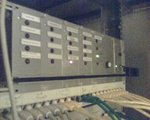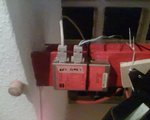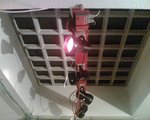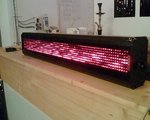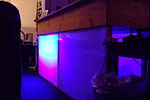Automatisierung des Labors/en
We have started to automate the Labor using a CAN bus. The LAP protocol has been developed to support our goal.
The basic idea is that we liked to have an automatic and convenient controller for all our lamps, the music and other fancy stuff. We had thought about providing a means of interaction to the system using common wall mounted light switches and remote controls as well as via a website in our intranet.
So far the automation has been used for the following tasks: When you leave the Labor in the evening (or the early morning...), a simple twist of our main power button engages the shutdown procedure, which will turn off the music, the audio hardware, the light, all computers and some other non-essential appliances. One can control the lights and the music for all rooms using a Funkfernbedienung/en remote control or the website.
Sounds practical, eh?
We have planned to extend the automation to do some other tasks as well, for example to separately control the power outlets located in the Labor.
Status
Assigned LAP Addresses
| Address | Device | Description |
|---|---|---|
| 0x00 | CAN-GW | at Roulette |
| 0x01 | The Might (aka The Switch) | |
| 0x24 | BORG | Long scrolltext borg |
| 0x31 | MOODBAR | Fluoerescent lamp dimmer bar (PC power supply case) |
| 0x35 | LAMPE | SpotControl (Metal case) |
| 0x3d | BORG-3D | Martin's 8x8x8 Blinken-Borg |
| 0xA1 | dr4go's Moodlight | |
| 0x42 | BORG | Andre's small 16x16 Blinkenlights |
| 0x43 | Dario's LaBORGjacket | |
| 0x53 | Gate opener | |
| 0x54 | Chuck/en | |
| 0xF? | BROADCAST | Special broadcast addresses |
| 0xFF | BROADCAST | All LAP Devices |
2.9.2005
For now we can already talk to the CAN controllers via the Labor Micro Board/en to send and receive CAN packets. We also have written a small software for Atmel microcontrollers which turns them into a CAN<->RS232 gateway. For the PC side, we've developed a client software, giving the computer the ability to send and receive CAN packets. It is even possible to tunnel the packets through ethernet.
CAN <-> RS232 Gateway
We've built a CAN RS232 gateway into a 19" rack-case.
Wir haben in ein 19' Rack Gehäuse, das ich mal aus dem Schrott gezogen habe, einen CAN RS232 Gateway eingebaut. Empfangene CAN Pakete werden dabei über RS232 getunnelt, so das eine Software auf einem Client PC diese wieder entkapseln kann.
In den Gehäuse gibt es ein Netzteil für die 13V Bus Spannung (Es wurde von 24V umgebaut), und eine Menge Leuchtedioden, um mal diverse Betriebszustände signalisieren zu können. Ausserdem ist eine Hauptplatine vorhanden, auf der ein Atmega8 werkelt. Auf diese Platine befinden sich auch die Bausteine für den CAN Bus, und ein Max232 für die serielle Seite. Ausserdem gibt es Schieberegister und 16 Treiberstufen für die LEDs im Rest des Rack Gehäuses (Die waren schon so...).
Dimmer für Spotstrahler
Ich habe in ein kleines Metallgehäuse einen Dimmer für unsere Spotlampen gebaut.
Das sind 30W/6V PAR36 Spots. In dem Gehäuse befindet sich nicht die Leistungselektronik, sondern nur die Ansteuerung. Die wird von einem (viel zu kleinen...) AT90S2313 übernommen. Daneben sind auch wieder die Chips für den CAN Bus angeordnet. Ausserdem gibt es ein Relais, dass die Spots 230V seitig vom Netz trennen kann.
Laufschrift Borg
Der Laufschrift-Borg an der Theke soll zur Joystick-Bedienung herhalten und Betriebszustände des Labors anzeigen.
Moodbar
Die Theke hat einen eingebauten 3-Kanal leuchtstofflampen-Dimmer -- und mischt so beliebige, wundervolle Farben
Technisches
Pinbelegung neuer Canbus Stecker
Draufsicht Wannenstecker: sicht von der Steckseite auf die Pins
9 7 5 3 1 +--------[ ]---------+ | 15V 15V GND CANH GND | | 15V 15V GND CANL GND | +----------------------+ 10 8 6 4 2
